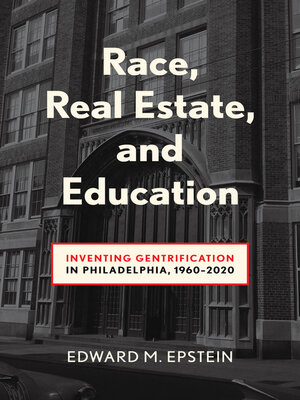Race, Real Estate and Education
ebook ∣ Inventing Gentrification in Philadelphia, 1960-2020 · Urban Life, Landscape and Policy
By Edward M. Epstein

Sign up to save your library
With an OverDrive account, you can save your favorite libraries for at-a-glance information about availability. Find out more about OverDrive accounts.
Find this title in Libby, the library reading app by OverDrive.



Search for a digital library with this title
Title found at these libraries:
| Library Name | Distance |
|---|---|
| Loading... |
Philadelphia's urban renewal efforts in the 1950s, which re-envisioned the city as a residential enclave, were an early example of gentrification. In West Philadelphia in the 1960s, a coalition of universities and hospitals went further, initiating K-12 public school improvements meant to attract an affluent and whiter population. As Edward Epstein details in Race, Real Estate, and Education, these interventions discounted the negative impact they could have on neighborhood residents.
Epstein outlines the citywide context for the plan to create "University City" in West Philadelphia. He recounts the attempts to correct the segregation, overcrowding, and authoritarian management that plagued Philadelphia's public schools. As the West Philadelphia Corporation, the proxy for the universities and hospitals, initiated gentrification efforts, the local community resisted and protested, causing the project to fail. The effort was revived with spectacular success, however, with the launch of the well-funded Penn Alexander School in 2001.
Race, Real Estate, and Education shows how the pursuit of urbanist ideals sometimes deepens neighborhood injustice. Epstein's exploration of whether Philadelphia's overall approach was beneficial or misguided presents a cautionary tale.
In the series Urban Life, Landscape, and Policy
Epstein outlines the citywide context for the plan to create "University City" in West Philadelphia. He recounts the attempts to correct the segregation, overcrowding, and authoritarian management that plagued Philadelphia's public schools. As the West Philadelphia Corporation, the proxy for the universities and hospitals, initiated gentrification efforts, the local community resisted and protested, causing the project to fail. The effort was revived with spectacular success, however, with the launch of the well-funded Penn Alexander School in 2001.
Race, Real Estate, and Education shows how the pursuit of urbanist ideals sometimes deepens neighborhood injustice. Epstein's exploration of whether Philadelphia's overall approach was beneficial or misguided presents a cautionary tale.
In the series Urban Life, Landscape, and Policy







